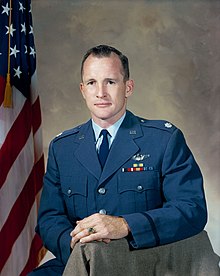Edward Higgins White
| Edward H. White II | |
|---|---|
 |
|
| NASA Astronaut | |
| Nationality | American |
| Born | Edward Higgins White II November 14, 1930 San Antonio, Texas, U.S. |
| Died | January 27, 1967 (aged 36) Cape Kennedy, Florida, U.S. |
|
Other occupation
|
Test pilot |
|
USMA, B.S. 1952 UMich, M.S. 1959 |
|
| Rank | Lieutenant colonel, USAF |
|
Time in space
|
4d 01h 56m |
| Selection | 1962 NASA Group 2 |
|
Total EVAs
|
1 |
|
Total EVA time
|
36 minutes |
| Missions | Gemini 4, Apollo 1 |
|
Mission insignia
|
|
| Awards |
|
Edward Higgins "Ed" White II (November 14, 1930 – January 27, 1967), (Lt Col, USAF), was an American aeronautical engineer, U.S. Air Force officer, test pilot, and NASA astronaut. On June 3, 1965, he became the first American to walk in space. White died along with astronauts Virgil "Gus" Grissom and Roger B. Chaffee during prelaunch testing for the first manned Apollo mission at Cape Canaveral. He was awarded the NASA Distinguished Service Medal for his flight in Gemini 4 and then awarded the Congressional Space Medal of Honor posthumously.
White was born on November 14, 1930, in San Antonio, Texas, to parents Edward H. White, Sr. (1901–1978), who became a major general in the U.S. Air Force, and Mary Rosina White (née Haller; 1900–1983). He attended school in his hometown and became a member of the Boy Scouts of America, where he earned the rank of Second Class Scout. After graduation from high school in 1948, he was accepted to the United States Military Academy at West Point, where in 1952 he earned his Bachelor of Science degree and was commissioned as a second lieutenant in the Air Force. Then, he attended flight school, a course that takes just over a year. Following graduation from flight school in 1953, White was assigned to the 22nd Fighter Day Squadron at Bitburg Air Base, West Germany. He spent three and a half years in West Germany flying in F-86 Sabre and F-100 Super Sabre squadrons in the defense of NATO.
...
Wikipedia
